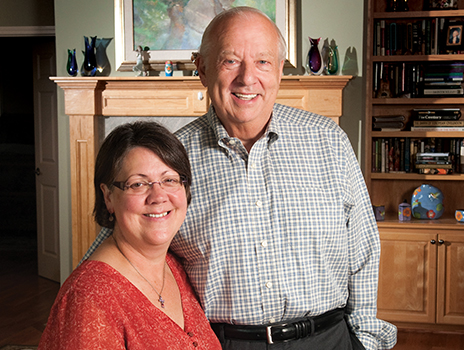- Home
- News Room
- Patient Stories Search Page
- Prostate Cancer Survivor Fights Fast, Aggressive Cancer
August 30, 2019
Retired as CEO of Farmland Industries, Bob had changed careers, studied ministry and become an ordained deacon on staff at St. Margaret’s Episcopal Church in Lawrence, Kansas. One day, when he was helping serve a meal to honor church volunteers, he missed the coffee cup he was trying to refill and slopped hot coffee on Emily Sinnard. Flustered and embarrassed, he apologized and said he’d have to buy her a cup of coffee sometime. Unfazed, she smiled and said she’d like that. “I can’t think of a worse pickup line than pouring coffee on someone!" he laughs.
It took Bob 3 months to work up the courage to follow through on that cup of coffee. But when he finally did, he and Emily talked for hours, finding much in common. He was widowed; she was long divorced. In no time, they had a standing dinner date each night before she went to work as a nursing supervisor. They shared so many meals, in fact, they both gained substantial weight that first year.
Fast forward to 2007, when they married, combining their families of 5 children and 5 grandchildren. Both reveled in a second chance at love, but Emily soon realized Bob was experiencing symptoms that could mean a prostate problem.
First he denied it. Then he downplayed the issue. Looking back, he admits that if his bride and one of his daughters hadn’t relentlessly pushed him to see his physician, continue to follow up, and ultimately find a specialist, he might well have ignored his symptoms until it was too late.
Frightening prostate cancer diagnosis
During those first months of marriage, Emily told everyone her new husband was one in a million. But as it turned out, he was 1 in 6. That’s the number of men who’ll be diagnosed with prostate cancer in their lifetime. Bob’s cancer was fast-growing and aggressive, rating a 9 on the 10-point Gleason scale used to stage prostate cancer.
“I thought I was gone,” he says. “I lost my first wife to cancer, so my attitude was pretty fatalistic in the beginning. But I quickly found out I knew a whole lot of guys who’d survived prostate cancer.” The Honses knew he should seek treatment at The University of Kansas Health System – an institution he’s well familiar with as former chair of the hospital board.
J. Brantley Thrasher, MD, urologic oncologist, met with them and was encouraging about Bob’s prognosis, despite the aggressiveness of his cancer. “Dr. Thrasher spent a great deal of time with Emily and me, describing the various treatment options. He was just very thorough and caring,” says Bob. Days later, Dr. Thrasher performed Bob’s surgery.
“Because I’m a nurse,” Emily explains, “Dr. Thrasher actually showed me what he removed.” A normal prostate gland is walnut-sized, she explained, but Bob’s was many times larger. “Had he waited any longer … ” her voice trails off.
Speedy recovery
“My overall patient experience at the hospital was absolutely wonderful,” Bob recalls. “I was there just 3 nights, and then back home.” Three weeks later, he and Emily were partying at Treads & Threads, The University of Kansas Health System's annual gala benefit for The University of Kansas Cancer Center.
After Bob's recovery, the couple returned to their busy lives, including trips to Russia, Italy, Germany, China, Hungary and others. And between the 2, they’ve lost more than 120 pounds. Though his schedule can be crowded, Bob still makes time to be a resource for other men diagnosed with prostate cancer.
“Nothing is as comforting as hearing from someone who has been through the same experience with cancer,” Bob says. “My favorite quote is, ‘Life’s not about waiting for the storms to pass ... It’s about learning to dance in the rain.' Hopefully, I’ve been able to help some people learn to dance in the rain.”
As with all treatments, individual patient results vary. It is important to discuss your treatment options with your healthcare provider.
